Thailand - Food Page 2
MSG (Mono Sodium Glutamate)
The first time my first Thai girlfriend decided to cook Thai food we went shopping to buy ingredients. As we were piling meat, seafood and vegetables into the trolley she suddenly remembered MSG and we had to ask an assistant where to find it. I was actually a little shocked that she wanted to put MSG in the food.
The reason I was shocked was because I had heard so many bad things about MSG. This impression was based on rumours, hearsay and old wives' tales rather than anything factual.
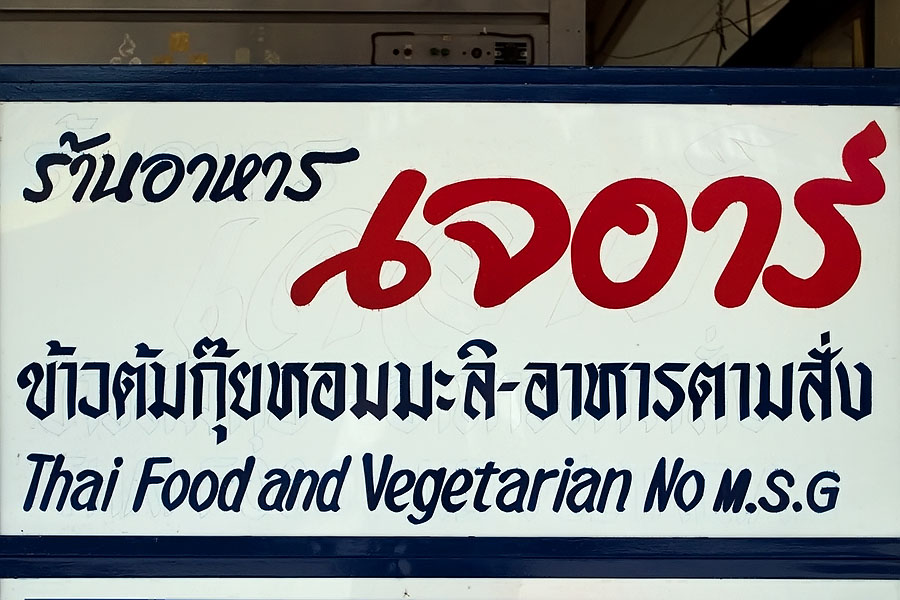
No MSG
I was led to believe that it was a very bad, man-made flavour enhancer designed to cheat diners by making food taste better but it was actually very bad for the body. Chinese takeaway restaurants in the UK and elsewhere have a particularly bad reputation for using excessive amounts of the stuff and hence the term 'Chinese Restaurant Syndrome'.
What Lonely Planet say in their write up is basically that MSG is OK. It's a naturally occurring substance and it isn't bad for us. In controlled tests it has been proven not to be an allergen. People who claim they are allergic to it are only suffering because they think it is bad for them. The power of the mind is a powerful thing.
MSG - The Special Ingredient That Makes Food Addictively Tasty - Won't Actually Hurt You
The Thai way of thinking is that it is not entirely harmless. Thais say that it makes bones brittle. However, used in small amounts it is not a problem.
It is widely used in Thai cooking, but in moderation. If you really want to insist that it isn't used in your food you can request, "Mai ao pong chuu rot" which translates roughly to "I don't want MSG." Some restaurants in farang tourist areas have latched on to the fact that this notion exists among some Westerners and make a big point that their food doesn't contain MSG.
It's really unnecessary, but if Thais know that foreigners want something or don't want something they try to please.
Kaaw Gairng
On a very simplistic level, Thai food can be divided into two categories. There are those dishes that are prepared at the start of the day, and dishes that are made fresh to order.
Food prepared at the start of the day and served in large trays is known as kaaw gairng (as written in Thai on the sign in the photo). It is very popular with Thais.
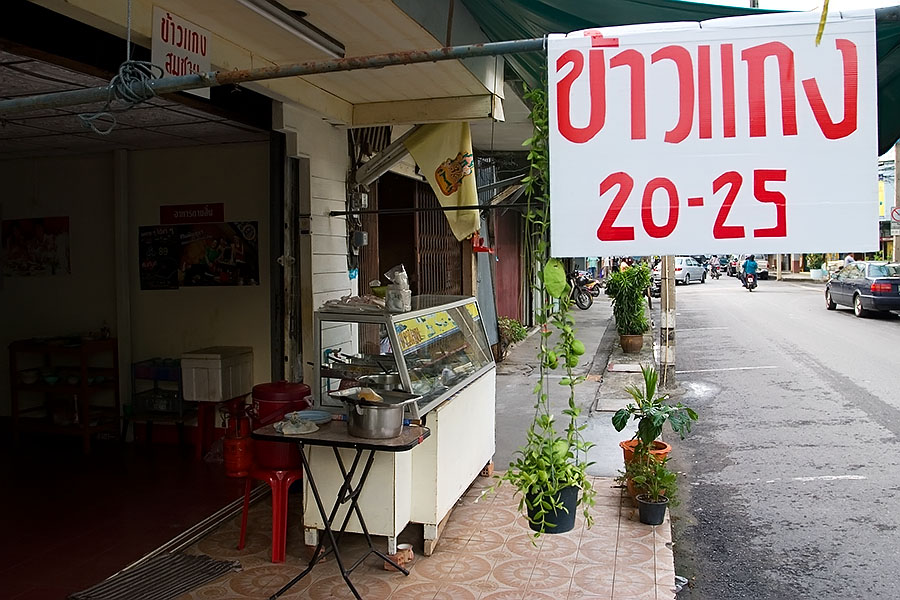
Kaaw Gairng
I never used to like it. No attempt is made to keep the food hot and it is normally eaten luke warm. However, I am quite keen on kaaw gairng now. It's cheap food - as the sign here says, just Bt20 to Bt25.
The person serving will first load the plate with a portion of rice and then it is up to you to choose two or three of the available dishes. What's on offer at any particular time varies enormously so I always look before I eat.
Sometimes kaaw gairng stalls have nothing at all that I find the least bit appetising whereas on other days there are several dishes that all look good.
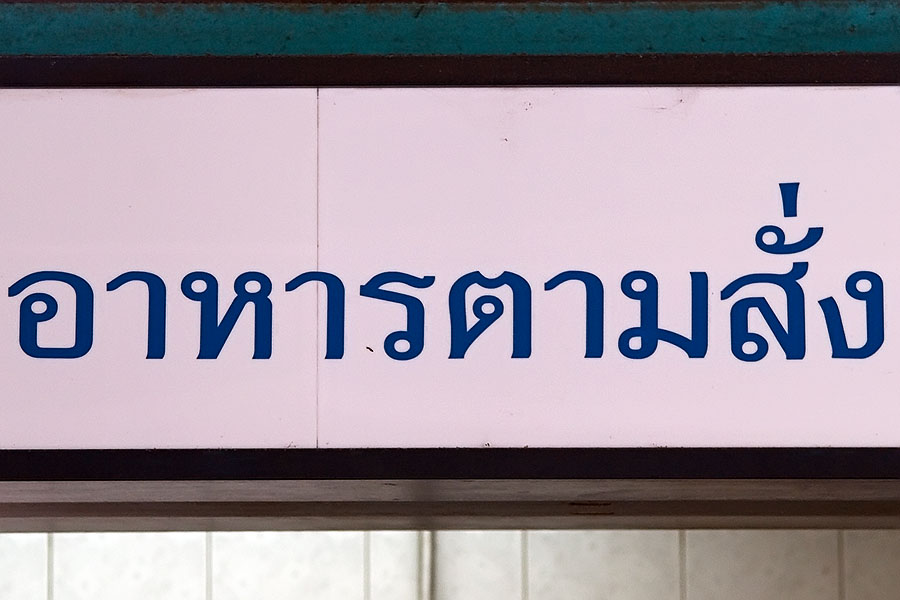
Aahaan dtaam sung
Sometimes, when you buy a bus ticket for a long journey, the fare will include a free meal during the journey. I can almost guarantee that the free meal at a provincial bus station will be kaaw gairng. You will be given a plate of steamed rice and it is up to you to choose whatever meat and vegetable dishes you want from the selection available.
Food cooked to order is known as aahaan dtaam sung (aahaan = food; dtaam = follow; sung = order). In kaaw gairng restaurants, a sign will normally be displayed if the restaurant also cooks food to order. It will be in Thai, of course, but reading this level of Thai isn't particularly difficult.
อาหารตามสั่ง
Thai Food
The food is quite varied and I will come on to a few dishes in a minute but without fail Thais eating Thai food will regard the food as delicious. They will ask you, "Aroi mai?" ("Is it delicious?") and you should, of course, reply that it is, "Aroi", or "Aroi maak" (very delicious). Some Thai food is delicious but, quite frankly, some isn't. Stewed pig offal at a wedding wasn't my idea of a wedding feast. The only time I ever see Thais screw their noses up at food and say "Mai aroi" (not delicious) is when I indulge myself in some farang food - bread or mashed potato.

Not only is Thai food delicious but it is very healthy (not to mention cheap)
Thai food isn't all spicy but bear in my mind that a Thai's view on whether something is spicy or not is very likely different to yours. I have been told many times, "Mai phet" (not spicy) and then a few minutes later broken out into a sweat. Most Thai food is cooked fresh after you order it so can be prepared to suit you. If you want a little bit of spice but not too much try saying, "Phet nit noi".
As in many parts of Asia, rice is the staple. In the north-east this takes the form of sticky rice (khao-niaow) that is served in a basket and eaten with the fingers. In the rest of Thailand steamed rice (khao-suai) or boiled rice (khao-tom) is more popular. One of the most common questions you will hear, apart from "Pai nai?" (where are you going) is "Gin khao rue yang?" which translates literally as "Have you eaten rice?" Rice will be served with food most of the time but noodles are also popular.
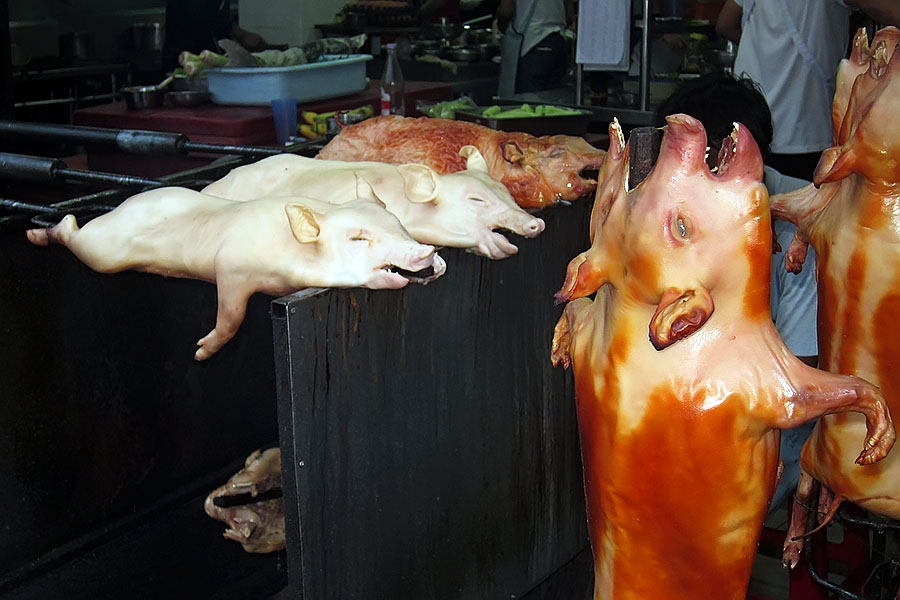
Suckling pigs; a Chinese favourite
The best thing to do in Thailand is experiment with the food and observe what other people are eating. If you are familiar with some dishes from Thai restaurants in your home country by all means try the same dishes in Thailand to see how they compare. Street food is so cheap that if you don't like something it is not a problem, just buy something else.
Some classic Thai dishes should definitely be sampled. Tom-Yum-Goong (hot and sour soup with prawns) is delicious but it can be very spicy. Ask for it to be toned down if you don't like very spicy food. Pad-Thai-Goong is a noodle dish served with egg and prawns. It is quite delicious and easily available in most of Thailand apart from Hat Yai for some reason. Fish is very popular and cheap compared to the West. It is normal to select a fish on display and then to tell the restaurant what kind of sauce you would like it cooked in. I eat fish in Thailand two or three times a week in Thailand compared to once a month or so back home.
In addition to classic Thai dishes ask around to see if there are any local specialities. Food varies quite a lot throughout Thailand. Isaan food is hot and spicy but very popular all over Thailand. Fish and seafood are popular in the south. In towns where there is a large Chinese population, such as Hat Yai, there is a definite Chinese influence on the cuisine, as might be expected. The roasted suckling pigs pictured are a typical Chinese favourite and where there are Chinese there will also be Dim Sum.
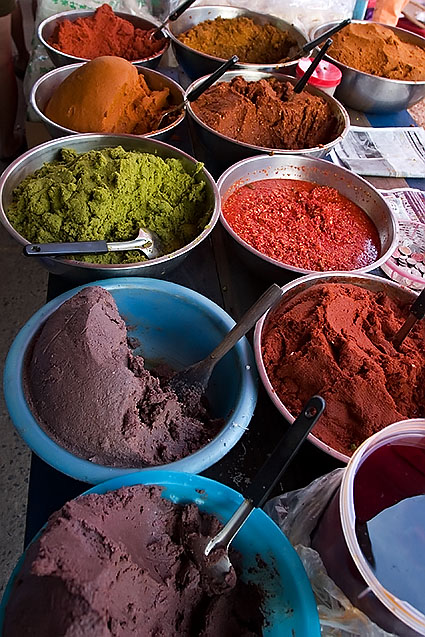
Various spices and curry pastes on sale at a local Thai fresh market
Balance is important with Thai food and to accompany meals a variety of condiments may be provided to add to the food. The idea with these condiments is they represent the different taste sensations. Typically you will see ground-up chilies (hot), vinegar (sour), sugar (sweet) and fish sauce (salt). Table salt will not be found in Thai restaurants apart from those in heavily touristed areas. Initially I thought the idea of adding sugar to my meal was most strange but it works, in moderation of course. It is also not unusual to be given a small plate of cucumber, a piece of lime to squeeze lime juice on to your meal and some leaves (sometimes mint) and shoots. I can't tell you what some of these things are as I don't know but generally I have enjoyed what has been provided.
Sometimes ground peanuts are served as a condiment with dishes like Pad Thai. I like them but I know that many people have a peanut allergy and eating peanuts can actually be quite dangerous for them. Remember this is Thailand and not America. Bags of peanuts do not come with a big warning on them saying 'This product contains peanuts'. Litigation and the culture of blaming someone else for whatever happens to you hasn't reached Thailand yet. The concept here is that you are responsible for your own actions. Careful then what you eat if you have any nasty allergies.
Personal Thai Food Guide
The picture shows a portion of put guh-prao gai with a fried egg (kai dao). It's delicious and available for between about Bt20 and Bt40.
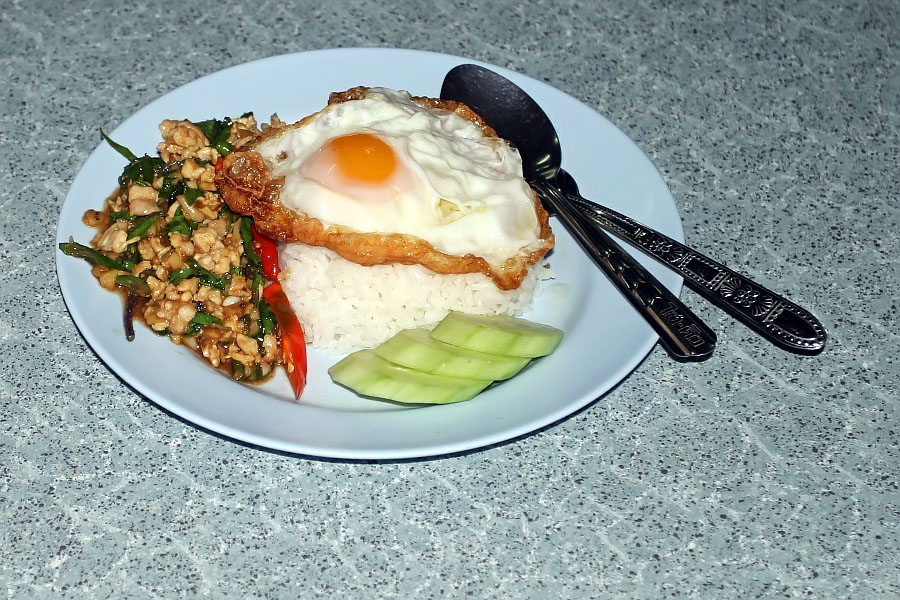
Put guh-prao gai (chicken with holy basil) and a fried egg on top
I have been wanting to expand this page of my site for some time as Thai cuisine is so rich and varied. However, thinking of the best way to do it has been difficult. My first thought was to try to cover all aspects of Thai food but it is a huge and daunting task. I am not an expert by any means so I would have had to obtain a lot of information from elsewhere.
There are already thousands of resources covering Thai food. If I tried to do the same it would take a lot of effort and the end result wouldn't be a fraction as good as what already exists. I believe that personal web sites should be about personal experiences and opinions. I have therefore decided to cover some of my personal experiences with Thai food and local restaurants.
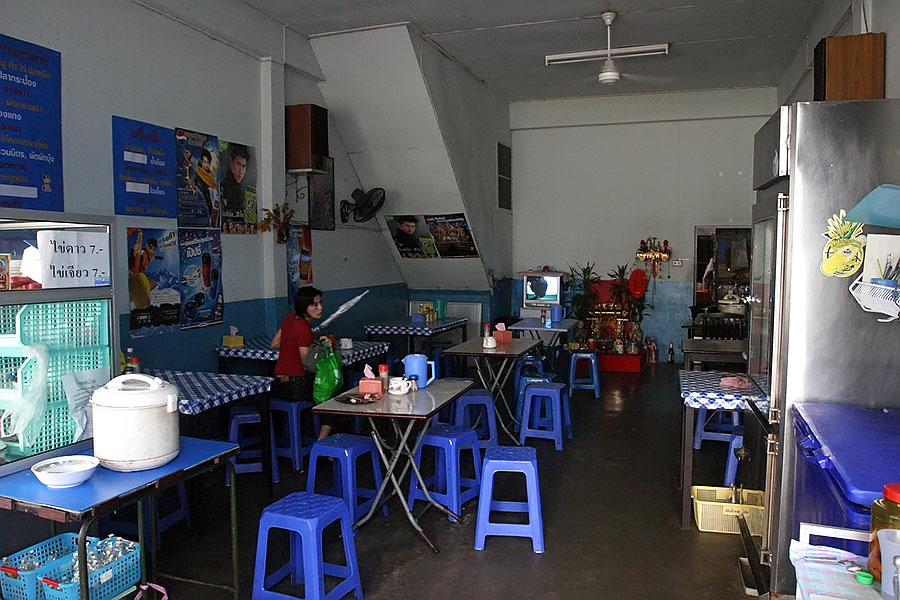
The decor in most local style Thai restaurants is what might be described as basic
I will begin with local restaurants, the kind that exist all over Thailand and can be found everywhere. When I started visiting Thailand I never used to eat in these places but now I eat in them all the time. What can be daunting for tourists is that there are no English language menus and the staff rarely speak English (this is especially so in the provinces) but actually you don't need to know much Thai to get by.
The typical decor is what might be described as basic - concrete floors, painted walls, Formica topped tables and plastic chairs. Table menus are rarely available but the menu will often be written on the wall in Thai. They aren't the plushest of establishments but you will get a delicious, healthy, freshly cooked meal for next to nothing.
Most small restaurants tend to do a limited number of dishes so you need to have made up your mind what you want first in order to go to the right place. There may be hundreds of different Thai dishes but most places I go to offer relatively few.
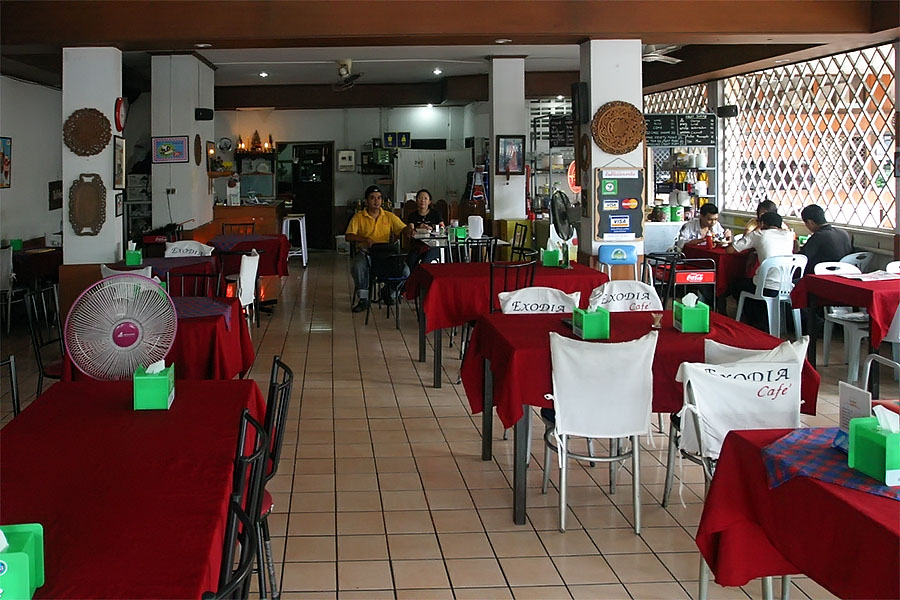
A slightly more upmarket Thai restaurant
Not all local restaurants are as basic as I have just described. This one has a much wider selection of food with a menu in Thai and English. They also serve a variety of ice cream desserts, including fried ice cream which is quite delicious, and even offer lessons in Thai cookery.
The rice dishes that appear all the time are khao put, put kreung gaeng, put phrik sot and put graphao. Put means shallow fried and all of these dishes are stir-fried in a wok. They are all cooked fresh and made in no time. The speed at which Thai cooks work amazes me.
Added to each of these dishes is meat or seafood. Typically the options will be goong (shrimp), gai (chicken), muu (pork), bplaa muuk (squid). Where I am, in the south of Thailand, beef (neua) is not often offered. Taa-leh (seafood) will result in shrimp and squid and maybe a few other shellfish depending on what's available. A fried egg (kai-dao) is often served on top of rice dishes.
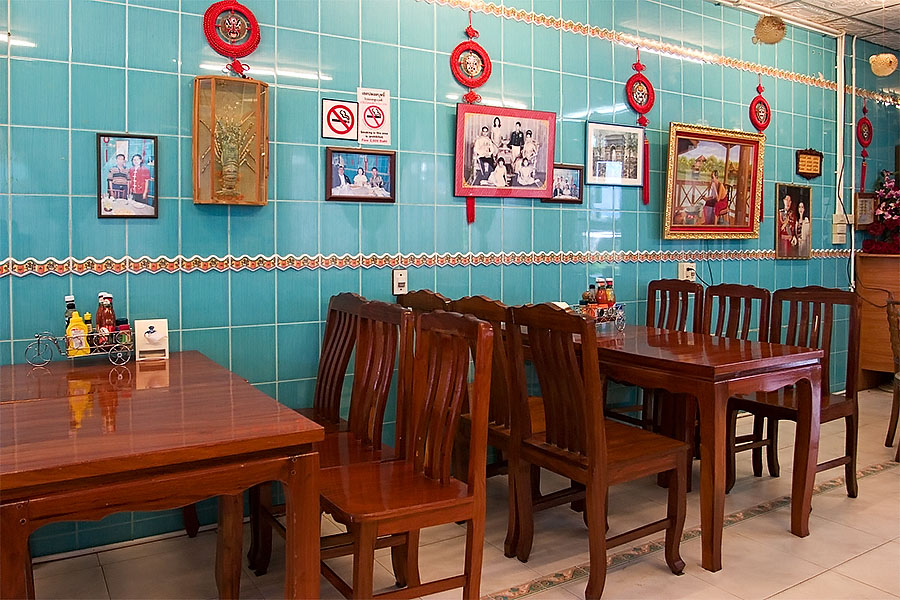
Inside a colourful Thai restaurant
Khao put is made up of steamed rice, eggs, spring onions, carrots, salt and soy sauce stir-fried in oil in a hot wok. The other dishes do not include rice but are served with a portion of steamed rice.
Put phrik sot means fresh, fried chilies. Small chilies and garlic are mashed to form a paste. Sliced onions, large chopped chilies, oyster sauce, sugar and soy sauce are added.
Put graphao is a very tasty and popular dish. It is made similarly to phad phrik sot but the large chopped chilies are exchanged for holy basil leaves.
Put kreung gaeng consists of dried chilies, garlic, small onions, lemongrass, turmeric and pepper.
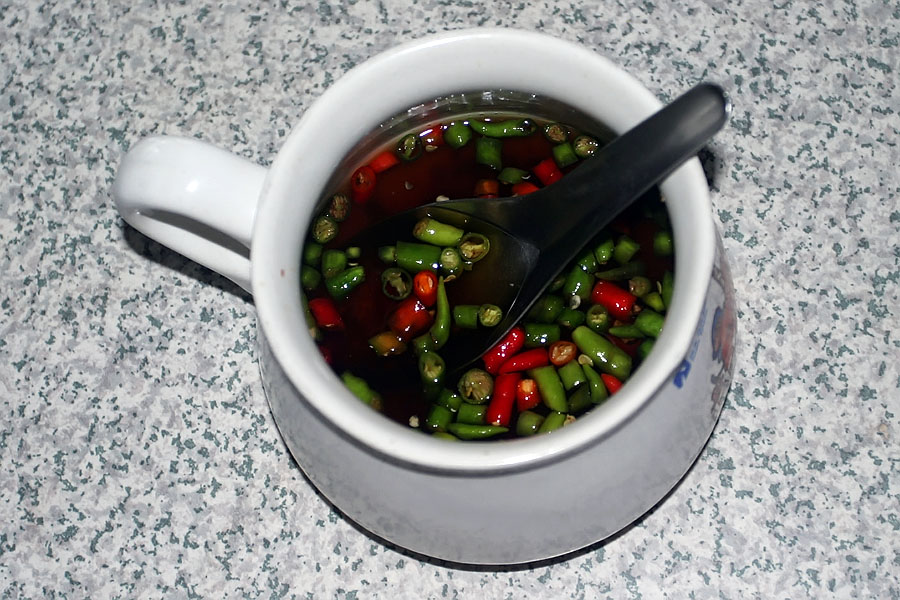
Fish sauce is used instead of granulated salt in Thailand to add saltiness to food
Thai condiments differ depending on what dish is being eaten but for rice dishes you will be given a small bowl of naam plaa phrik which is fish sauce made from fermented anchovies containing chopped chilies.
Soups are popular with the Thais but they aren't eaten as a starter as they might be elsewhere. Instead they come as part of the main meal and one large bowl of soup is shared amongst the diners. Probably the most famous of all Thai soups is dtom-yum. It contains sliced galanga, lemongrass, lemon leaves, shallots, chilies, tomatoes, mushrooms which are all added to a chicken stock. Added flavouring comes from salt, fish sauce, chili paste and lemon juice.
It is commonly made with shrimps (dtom-yum goong) but can also be ordered with chicken instead (dtom-yum gai) or seafood (dtom-yum taa-leh). It has a delicious clean taste but the spiciness can blow your head off. I have not been able to eat dtom-yum at times because it has been too hot for me.
Dtom kha gai is a much milder soup based on coconut cream and it is only ever made with chicken. It has a very pleasant taste. It contains sliced galanga, lemongrass, shallots, mushrooms, lemon leaves, coconut cream, chicken, salt, fish sauce and lemon juice.
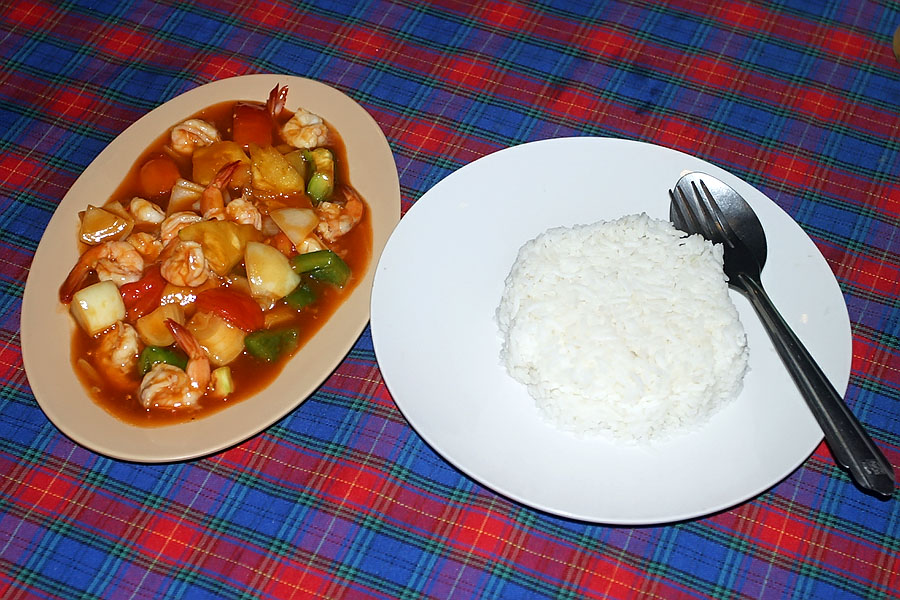
Thai style sweet-and-sour dishes are very different to the Chinese versions
Thai 'sweet and sour' dishes (put bprio wahn) are entirely different to the Chinese style sweet and sour dishes I am accustomed to eating in the UK. There is no batter involved and they are shallow fried in a wok. The sweetness comes mainly from pineapples. Other ingredients include onions, tomatoes, bell peppers, chili sauce, sugar, oyster sauce and lemon juice. As with other Thai dishes, different meats are used depending on what is available. The picture shows a dish of sweet and sour shrimps.
The Thai food I eat in Thailand is quite different to the Thai food I have eaten in Thai restaurants outside of Thailand but one dish is fairly consistent and that is green curry (gaeng kiew wahn). It is a fairly mild, sweet curry and extremely delicious. Chefs tend to use a pre-prepared green curry paste to make it and add coconut cream, egg plant, baby corns, sweet basil, fish sauce and sugar. It can be eaten with fish or different kinds of meat but personally I always have it with chicken.
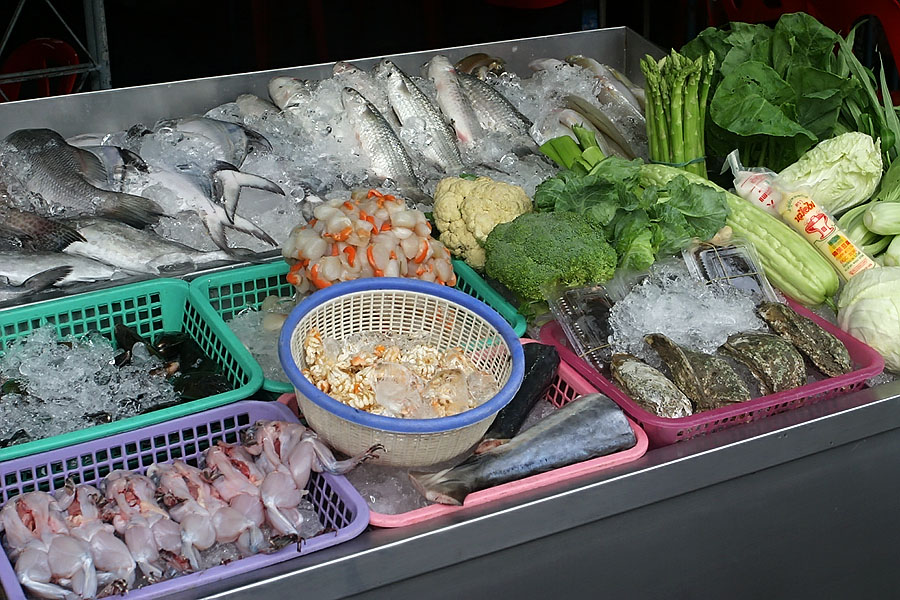
Fish and seafood restaurants usually display the raw fish on ice at the front of the restaurant
Fish and seafood are not to be missed, especially in the south where both are abundant and cheap. Fresh fish might be an expensive option elsewhere in the world but not in Thailand. It is quite common for the fish to be displayed on ice outside the restaurant. You first choose your fish whereupon it will be weighed and the price given.
You will then be asked how you want it cooked and the Thais are experts at preparing and cooking fish. It can be steamed in lemon or fried in a variety of sauces. They somehow make it crispy but moist and succulent at the same time.
In addition to fish, seafood restaurants will have a selection of whatever else has been freshly caught. Choose from shrimp, squid, lobster, crabs (which will still be alive when you choose one), mussels, etc. If you look closely at the photo you might notice some skinned frogs at the bottom on the left. These are a favourite with Chinese diners.
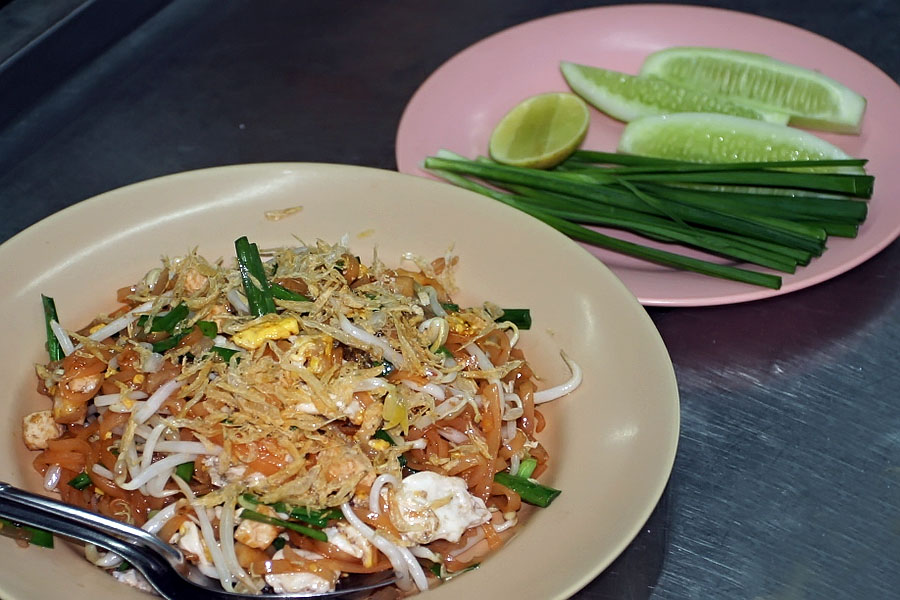
Phad Thai
Phad Thai is a classic dish that many foreigners know of and I eat it at least once a week. The main ingredient is flat rice noodles and it has a lovely fresh taste due to lots of beansprouts, spring onions and lime juice. Fish sauce and small, sweet, dried shrimps give it a fishy taste and it is often served with a few fat, juicy shrimps. Sometimes it comes with ground-up peanuts and at other times the peanuts are offered as a condiment to be added by the customer.
I believe that in Bangkok Phad Thai can be bought for as little as Bt15. I pay from Bt25 to Bt40. It's more expensive with a helping of fat prawns of course.
You don't need to own a restaurant to set up a food-selling business in Thailand. One of the joys of Thailand is that there is food everywhere. Sometimes it seems that the whole country is one big restaurant. People set up stalls by the roadside or operate from motorcycle sidecars. The stalls are in the same location each day but the mobile vendors drive around, stopping wherever there are potential customers.
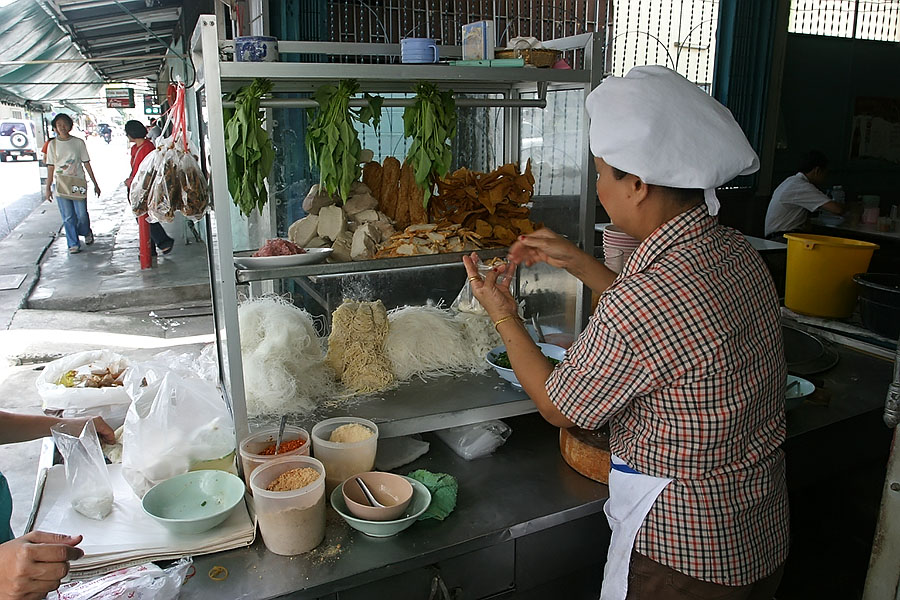
Noodles are also very popular
The large ethnic Chinese population has made a huge impact on Thai culture and this is reflected in the food. Gway-tiaow is now an established part of Thai cuisine but it is basically a Chinese dish. The Thais love it.
Different types of noodles are available and the selection varies from place to place. Choose between sen or mee (rice or wheat) noodles and also choose the size - yai or lek. Yellow noodles (sen luang) are also offered sometimes but I'm not sure what these are exactly. In the picture you might just be able to make out four kinds of noodles beneath the fish and pork.
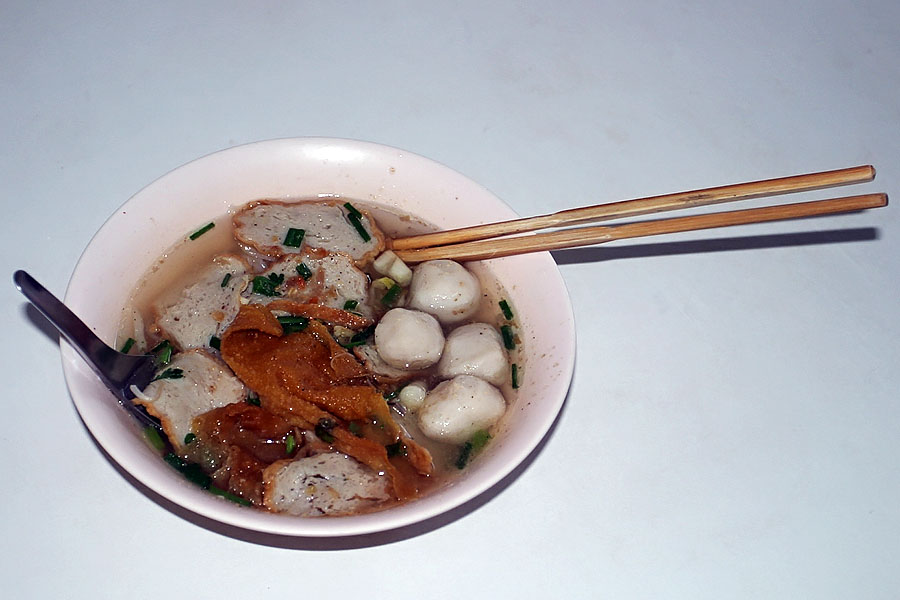
Noodle soup with fish
Once you've selected your noodle style you need to decide what to have with them. Pork or fish are common choices. The fish comes as fish balls and sometimes fish stomach is added for some extra flavour.
Now you need to decide whether to have it dry (haeng) or in a soup (naam). If in a soup, a clear stock is added to the bowl which includes some chopped spring onions, MSG and pepper powder. To eat the solid parts of the meal chopsticks are used and a Chinese-style soup spoon is provided to drink the soup. I don't eat gway-tiaow as often as I eat rice but it makes a nice change occasionally.
Just as foreign men love the hot and spicy girls of Isaan, Thais love food from the same region. It's a unique cuisine but so well integrated into the regular diet that it doesn't appear so. Som-tum, the spicy salad normally made from shredded papaya but occasionally made from shredded carrot, is arguably one of Thailand's most famous national dishes but it comes from the north-east originally. Isaan food is characterised by very fresh, clean tastes from lots of fresh herb leaves and is tangy from liberal amounts of lemon juice but it is very, very spicy.
Restaurants do exist that specialise solely in Isaan cuisine but more often that not restaurants will include Isaan dishes in the menu alongside food from other parts of Thailand. Very popular is yum, another kind of spicy salad. It can be ordered with glass noodles (yum wun sen) or with instant noodles - the kind that come in pot noodles. The latter is known as yum ma-ma. Ma-ma is a popular brand of instant noodles in Thailand.
The salad is made in different ways but will typically include onions, shallots, chilis, celery, tomato, lemon juice, sugar and fish sauce. Not how different tastes are incorporated in one dish - a common technique in Thai cooking. The fish sauce is salty (kem), the lemon juice is sour/bitter (bprio) and the sugar is sweet (waahn).
Yum is good with seafood (taa-leh) or it can be ordered with minced pork. Yum bplaa duuk fu (catfish) is made with shredded mangoes.
Laap is another Isaan dish and can be ordered with chicken (laap gai) or pork (laap mu). The meat is chopped very finely, as are the hot chilis and lemon juice is added. This is a very tasty dish but on occasions I have been unable to finish it because the spiciness has been too much for me. Because of the way many Isaan dishes are prepared it is not possible to push the hot chilis to the side of your plate.
Fresh Markets (dta-laat soht)
The local fresh markets fascinate me and are always a great place to wander around. A word of warning though, the sights and smells can be quite overwhelming at times. The markets start early in the morning and tend to peter out shortly after lunchtime. These are the places where the majority of normal Thais come to do their food shopping, buying food for their families or small restaurant businesses. That's because prices are the cheapest you will find in Thailand.
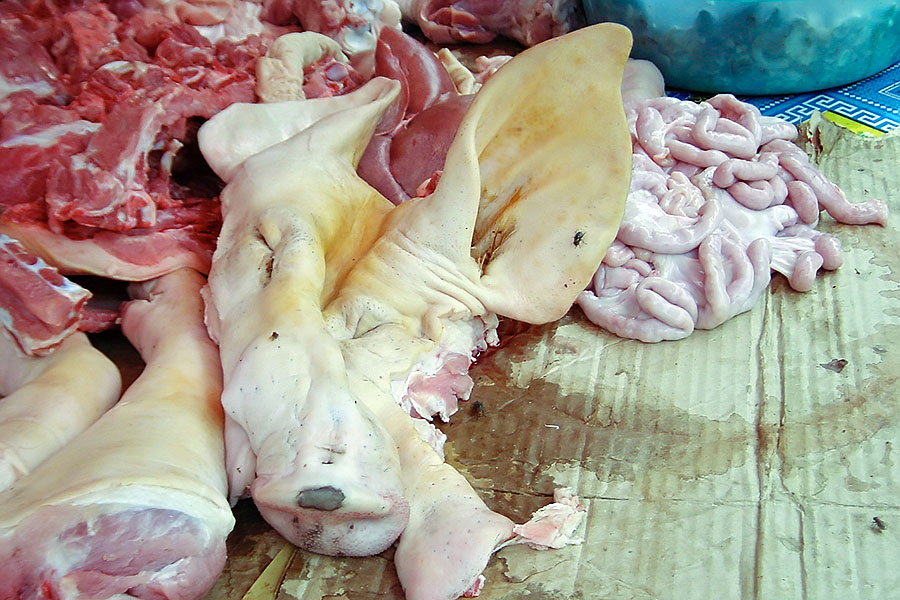
No part of the pig is wasted and flies come at no extra charge
They are not for the squeamish. Meat generally is not refrigerated and is left open to the elements. Swarms of flies land on it and sometimes, but not always, the shop owner will wave a stick around to deter them. With an animal like a pig nothing is regarded as worthless so all of its bits are on display to be sold. The pigs head, stomach, internal organs and yards of intestines sit on a slab alongside the more palatable cuts of meat. The smell of all this flesh in the hot Thai weather can be overpowering. Sometimes I have to hold my breath and walk past very quickly.
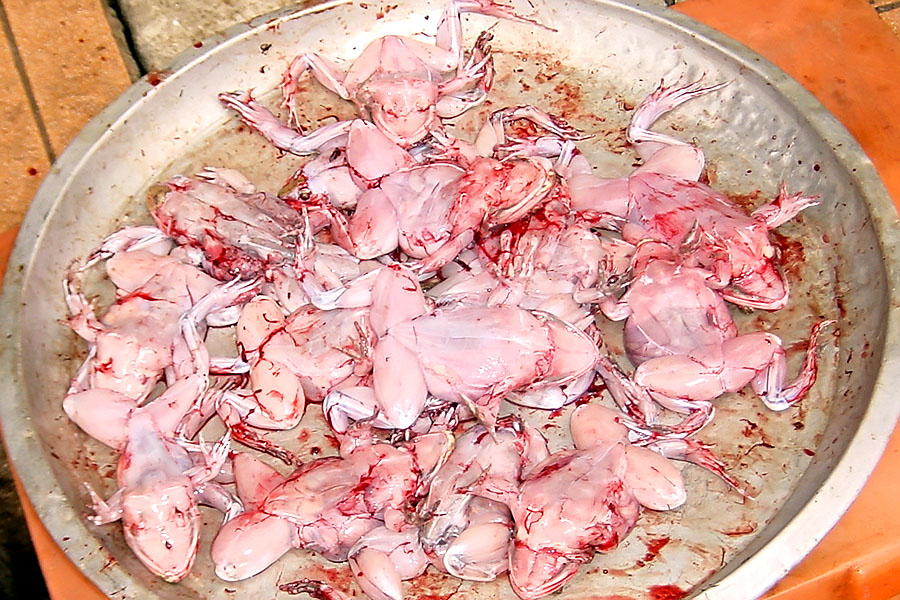
Freshly skinned frogs ready for the pot
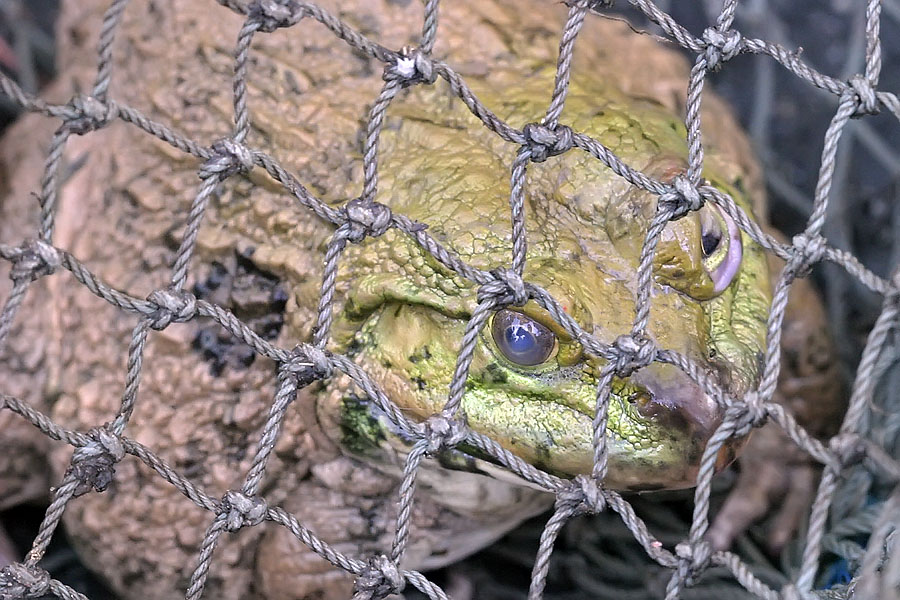
You're next ...
Fish and seafood are normally kept on ice unless of course they are still alive. The catfish are normally alive because they can live out of water. Presumably they must have lungs instead of (or as well as) gills. It's a bit gory watching them having their heads cut off still alive. The same applies to some freshly skinned frogs I saw that were still alive.
The fruit, vegetables and spices are a lot easier to handle for Western sensibilities. I'm happy buying fruit at the market but even if I did my own cooking I wouldn't be too comfortable buying meat. Ironically I have seen the woman who runs my favourite restaurant at the market. She goes there every day to buy what she needs. I therefore do eat meat that's been bought at the market but I only see it once it has been cooked.
Vegetarian Food
Vegetarian food (aahaan jay) is quite widely available in Thailand, but you may need the help of locals or a good guide book to find the location of restaurants. If you happen to be in Hat Yai, I have listed some vegetarian restaurants within my website's food pages.
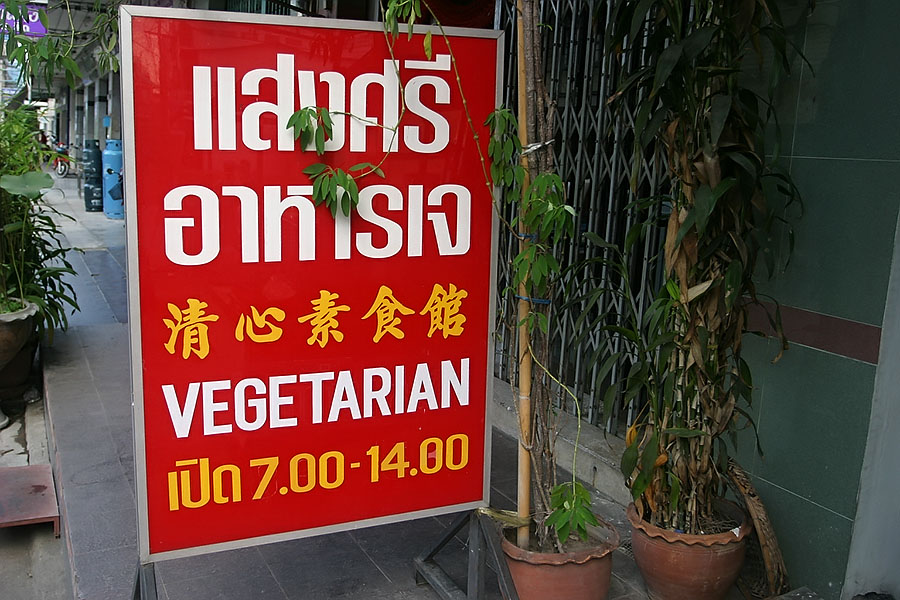
Vegetarian food is quite easy to find in Thailand
Some Chinese Buddhists, in particular followers of the Kuan Im religion, follow a vegetarian lifestyle. The biggest public display of vegetarianism is probably the Vegetarian Festival in Phuket which takes place in the ninth month of the lunar calendar. A similar event also takes place in Hat Yai and in some other Thai towns with ethnic Chinese populations.
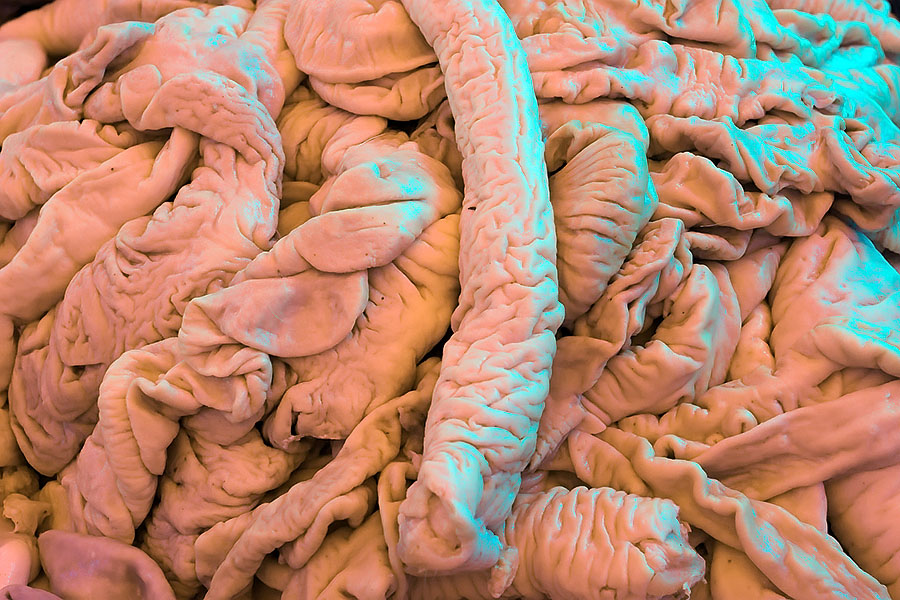
IMHO, anything veggie is better than pig offal
I'm not a vegetarian but eat vegetarian food occasionally and it can be quite tasty. I normally visit the vegetarian festival in Hat Yai every year and eat vegetarian food there.
Some vegetarians claim that humans weren't designed to eat meat. They say our teeth and other anatomical features, such as the length of our digestive tracts in relationship to the length of our bodies, is closer to plant and fruit eating animals than meat eating ones. They say that the anatomy of carnivorous animals is very different. I don't know how factual these claims are, but I believe that our diet should be balanced just like everything else in our lives.
I stopped eating pork in Thailand very shortly after I arrived to live in Thailand. The main factor was a few too many visits to Thai fresh markets where I observed how pork is sold - uncovered and unrefrigerated in stifling heat, and covered with flies with the vendor trying to keep the flies away by waving a stick.
Another factor is how it is cooked. It is normally fried in Thailand whereas in the past I have only been used to eating roast pork.
At a wedding I attended where the only meat available was stewed pig offal, which made my stomach churn, I had to lie in order to avoid eating it. I told them I was Jewish. With my nose, this claim is perfectly believable.
If you are a strict vegetarian, the following advice from a vegetarian friend living and working in Bangkok may be useful.
"While Thailand has a wonderful variety of foodstuffs on offer, including many kinds of fruit and vegetables, vegetarians and vegans should beware: often even big, impressive stores such as Emporium and Central will have a salad bar that contains salad dishes comprising not only vegetables but meat and fish as well. This very morning I saw a salad bar boasting a large bowl of potato salad and tuna fish mixed together, with a sign beside it that read: Vegetarian! So if you are vegetarian in Thailand, look carefully before you purchase!"

